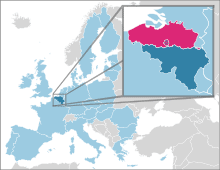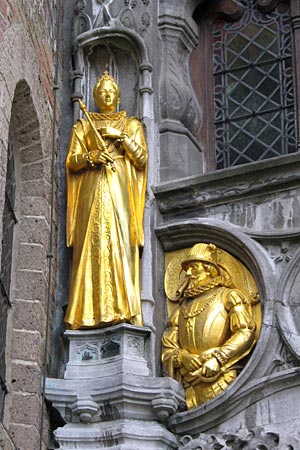Flanders is the Northern Dutch-speaking Region of Belgium. The Walloon Region in the South of the Country, is French-speaking. Brussels (the dot within Flemish territory) it the capital of Belgium and both regions. |
Historical Notes
Flanders is also the name of a geographical area, comprising the western part of the political Flemish region (political West and East Flanders), and parts of northern France and the southern Netherlands. In bygone times, these parts formed the County of Flanders, with its main cities Bruges and Ghent. Flanders was a fief of France.
Brussels, Leuven, Antwerp and Mechelen where located in the Duchy of Brabant (which also included parts of the present-day Netherlands). The border between the County of Flanders and the Duchy of Brabant was formed (very roughly) by the river Scheldt. The Duchy of Brabant was part of the Holy Roman Empire.
Mainly through an arrangement of marriages, the County of Flanders and the Duchy of Brabant (and lots of of other smaller territories, it is really complicated) became united during the 14th and 15th centuries. The County of Flanders was 'acquired' by the House of Valois-Burgundy (from present-day eastern France) in 1384. The Burgundian territories further expanded and in 1430 the Duchy of Brabant was included. The Burgundian Netherlands (or Seventeen Provinces) covered most of present-day Belgium and the Netherlands.
The Low Countries portion of the Duchy of Burgundy passed to the Habsburgs in 1482. From 1549, Spanish Habsburg ruled the area. The northern provinces (covering mostly present-day Netherlands) of the Seventeen declared their independence from Habsburg Spain in 1581. Underlying this was the religious conflict between catholics and emerging protestants at the time. Through bloody repression the southern provinces (Belgium) remained under Spanish rule.
Later, after the War of Spanish Succession, the Austrian Habsburgs ruled the southern provinces from 1713 till 1795.
After their revolution, the French occupied the region after 1795. Then again, after the defeat of Napoleon in 1815, the 'Low Countries' were briefly united till 1830, as the United Kingdom of the Netherlands.
After the Belgian Revolution of 1830, Belgium became independent and separated again from the present-day Netherlands.
Concept, pictures, videos and website design by G.V., Bangkok/Flanders. Contact
Gilded Statues on exterior of the Basilica of the Holy Blood in Bruges. |

